How To Clean Every Type of Utility Sink? | Palmgear
by William Sanders
A utility sink is the most versatile sink you can install in your home. It can handle many tasks, including soaking your laundry, rinsing your dirty boots and clothing, cleaning tools such as paintbrushes, bathing your four-legged friends, and more.
Tasked with handling all these functions, it’s easy to understand why your utility can get easily stained. Even worse, most of the sinks today come in white and other light colors, which get easily get stained.
However, proper cleaning can restore the glory of your utility sink and make it spotlessly clean. This guide will take you through the safest and most effective method for cleaning your utility sink.
Contents

How To Clean Your Utility Sink
As you’re already aware, the utility sinks you’ll find on the market today are made from different materials. The most common material is plastic…but you can also come across models made from concrete, cast iron, stainless steel, fiberglass, acrylic, and more.

Regardless of which of the above materials is used to make your utility sink, you can get rid of stains on it using the same method—the baking soda or vinegar, or both—as we have explained in the steps below.
Step 1—Spray your sink with vinegar
Start the cleaning process by wiping your sink dry with a soft, clean cloth. Make a mixture of ¼-cup of white distilled vinegar plus 1 cup of water and put it into a spray bottle. Spray this mixture on your laundry sink; you can spray the stained areas or the entire sink surface. Give the mix around 10-15 minutes to do its job.
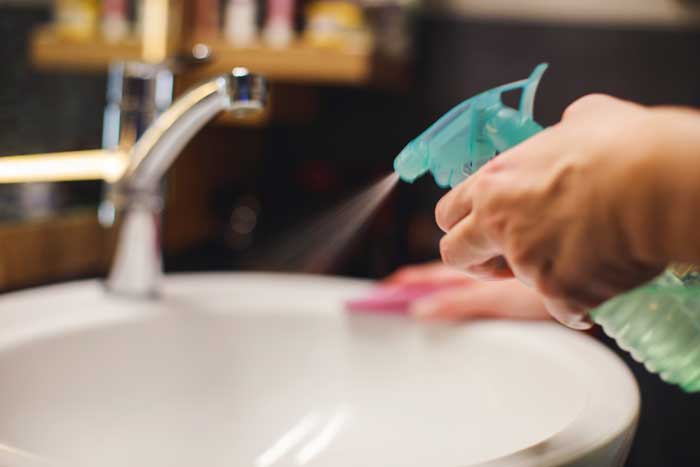
Step 2—Scrub it with a soft-bristled brush
Using a damp cloth dipped in warm water, rub the areas of the sink you have sprayed with the vinegar mixture. This will help reveal whether the stains have disappeared.
If the stains are still there, we advise you to repeat the spraying and allows the mixture to sit for another 10-15 minutes. This time, use a soft-bristled scrub brush to gently scrub the sink.
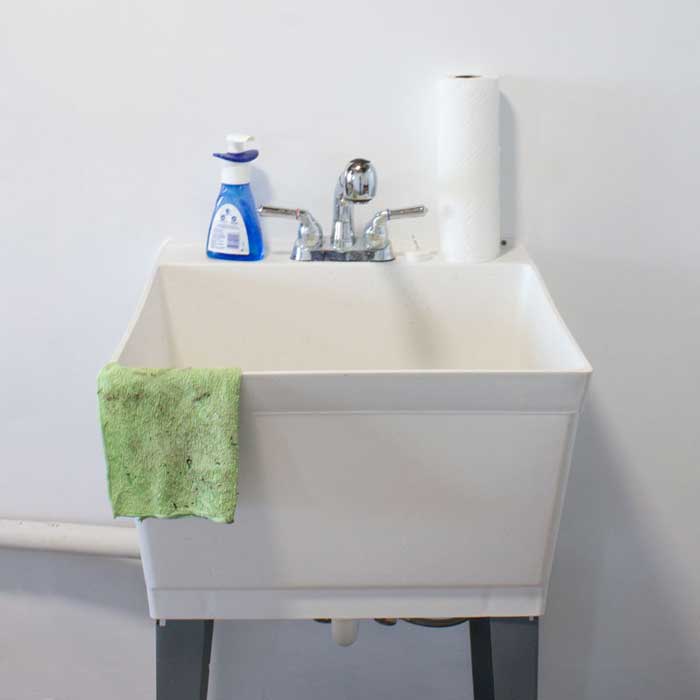
WARNING: You might be tempted to use a hard bristled brush, thinking that it will easily get rid of the stains, but we advise you against doing it as it can easily scratch your sink. Just use a soft brush for this step.
Step 3—Boost the vinegar mix with baking soda
If the stains still prove stubborn, even after respraying the sink, then you can consider boosting the cleaning power of your mixture by adding baking soda.
To do that, you’ll need to mix one-part water, one-part vinegar or lemon juice, and one-part baking soda. This mixture will form into a paste that you can apply to the stained areas of your sink.
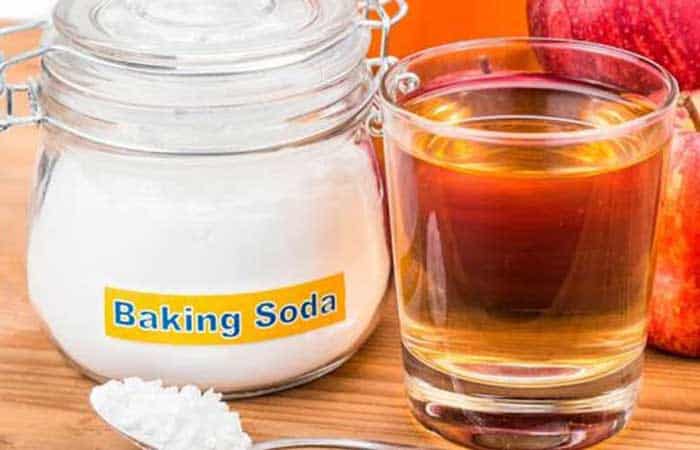
Allow the paste to sit for approx. 30 seconds and then scrub it using a soft-bristled scrub brush.
Step 4—Rinse your sink with clean water
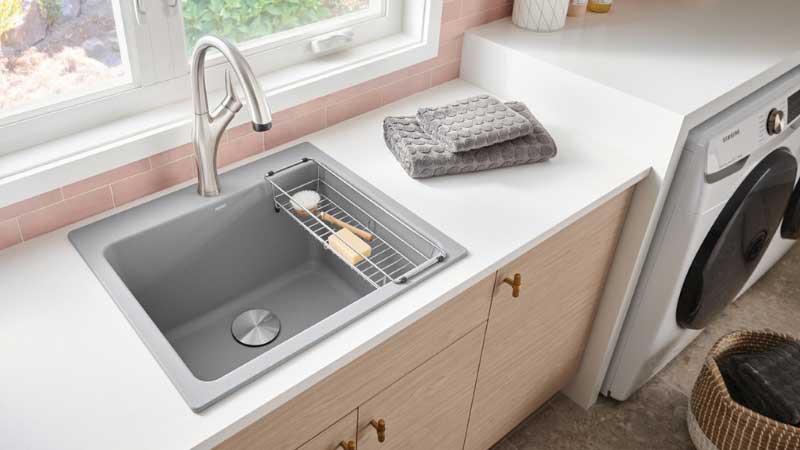
The last step involves rinsing the sink with some warm water, or you can use a damp cloth dipped in warm water.
If, after rinsing, you can still spot stains on your utility sink, repeat the whole process all over again. Yes, just don’t give up. You might only be a step away from making your sink spotless clean.
And after you repeat the process, be sure to fill your sink with hot soapy water (use hot water from the hot water line of your utility sink faucet and add enough soap dish to produce suds). Let it stay for approx. 30 minutes before you drain the sink to finish off the cleaning process.
How To Remove Paint From Utility Sink?
If you’re dealing with a utility sink with paint stains, then the cleaning process will be slightly different from that of soap scum stains we’ve just discussed above.
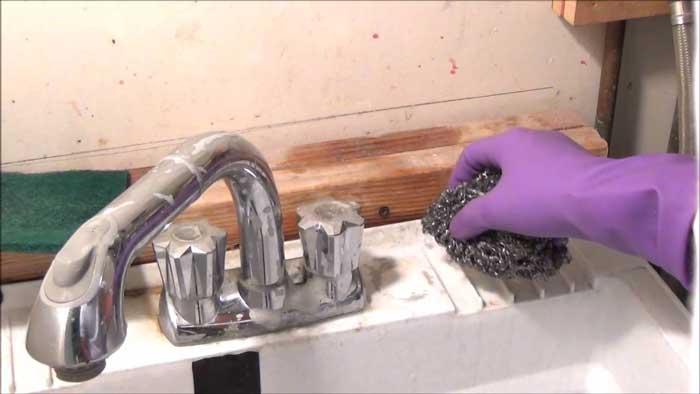
The supplies you’ll need include
- WD-40 cleaning agent
- Plastic ice scrapper
- Water
- Dish soap
- Cloth scouring sponge
Directions
Step 1—Spray WD-40 on the sink
Spray the utility sink area with the paint splatter with the Wd-40. Give it around 10-15 minutes to work. Note that the duration for proper penetration of WD-40 can be longer depending on the paint thickness, type of paint, and how long the stain has been on your sink.
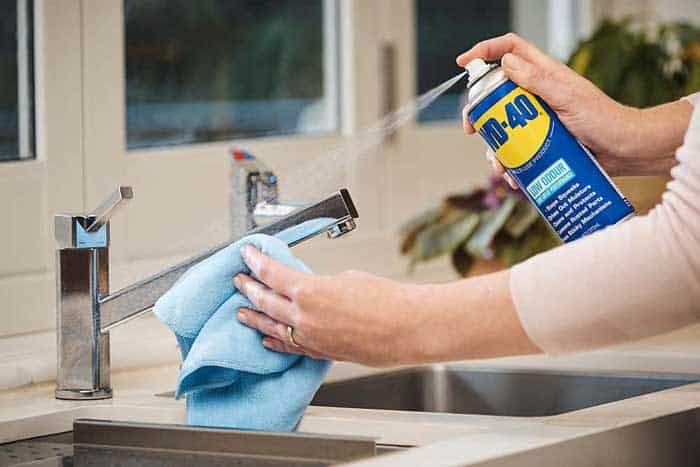
Step 2—Scrap off the paint
After waiting for the recommended period of time, the WD-40 will have softened the paint on your sink. You can use the plastic ice scraper to remove the paint splatter. If all the paint stain doesn’t come off, respray the W4-40, give it time to work and try scrapping it again.
Step 3—Scrub the sink with a scouring sponge
if the paint seems to be flush with your utility sink and won’t go away with scrapping alone, consider spraying it properly with wd-40. Gently scrub the surface with the cloth scouring sponge.
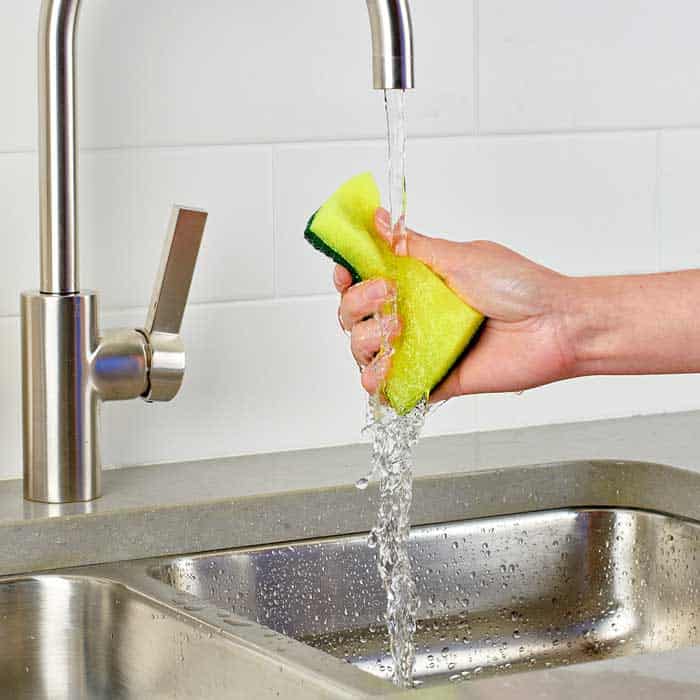
DON’T use those abrasive pads for this step as they may create grooves to your sink surface. These grooves will then harbor dirt easily and cause your sink to appear dirty quickly.
Repeat steps 1-3 until all the paint is gone.
Step 4—Get rid of residue WD-40
Having removed all the paint, all that’s remaining now is to wash your utility sink to remove the WD 40 residue. Water and dish soap will get rid of the residue pretty easily.
You might also use the scouring pad to remove any trace amounts of paint remaining on the sink. Rinse the sink, and you’re done!
Bonus step—Fixing clogged utility sink drain
The good thing about WD-40 is that it also acts as a great drain cleaner. You simply add a small amount of this cleaning agent to your sink drain and allow it to sit for about 10-15 minutes before flushing it down with normal water.
The agent works by getting right under the build-up and much in your sink drain and breaking it down to make it easy to clear. Moreover, it loosens up any rust to metal bonds, so it will be able to remove any internal rusting forming in your sink drain.
However, you should use this method if simple unclog methods like using a plunger or the drain snake doesn’t seem to resolve the drain clog.
Final Word
Cleaning your utility sink shouldn’t be a challenge if you know the right cleaning agents to use and the steps for cleaning it. Whether you’re dealing with stubborn soap scum stains or paint splatter on your sink, follow this simple guide to get rid of them and make your sink look clean.
 |
 |
 |
 |
 |
 |
 |
 |

About William Sanders
William Sanders was born and raised in California. After receiving his Master’s degree in information science from San Diego State University, he started working as a city councilor. In his spare time, William enjoys playing best-selling MMORPG games such as World of Warcraft and Fnal Fantasy, where he often takes on the role of guild leader with hundreds of players collaborating for success under his leadership. William is also a regular contributor to some popular magazines such as San Jose Mercury News, Gleanster Research, and Palmgear.
Leave a Reply
You can get FREE Gifts. Or latest Free phones here.
Disable Ad block to reveal all the info. Once done, hit a button below
 |
 |
 |
 |